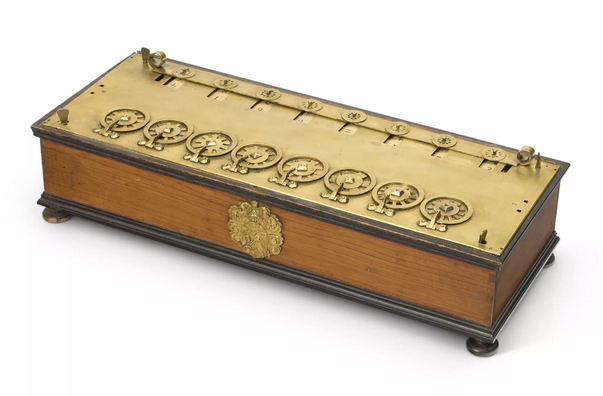La Pascaline, for the First Time in History, a Machine replaces the Human Brain at Auction

Developed by Blaise Pascal in 1642, the Pascaline is a scientific instrument of considerable historical value.
Undoubtedly the most important scientific instrument ever offered at auction, its inclusion in the 19 November sale of the Bibliothèque Léon Parcé, is an event of great magnitude.
The Pascaline is much more than a simple mechanical object: it is the first attempt in history to substitute the human mind with a machine. Its invention marks a breakthrough, a 'quantum leap' whose importance and significance take on a very special meaning today.
Gilberte Périer, Pascal's sister, in Vie de M. Pascal : Edition de 1712 : “{…} This work was considered a novelty in that it reduced an entirely mental science to a machine and found a way to perform all of its operations with complete certainty, without the need for reasoning. {…}
Such a bold conceptual and metaphysical innovation could only have sprung from one of the most brilliant polymaths in history. Author of a Traité des Sons [treatise on the communication of sounds] at the age of 12, of an essai de géométrie [essay on conic sections] at 16, Blaise Pascal developed the first calculating machine in history at the age of 19. He did so to assist his father, Etienne Pascal, President of the Cour des Aides de Normandie [Board of Excise]. As such, Etienne Pascal was responsible for re-organizing the province's tax revenues – a task requiring countless mathematical operations, accounting calculations and other topographical surveys. To simplify the process, Blaise Pascal designed calculating machines. For the first time in history mental arithmetic had been mechanized. Blaise Pascal designed three types of machines: one for decimal calculations (additions, subtractions, multiplications and divisions), one for accounting (for monetary calculations) and one for surveying (for calculating distances).
Only nine original models of this major scientific and technical revolution remain in existence, all of which are held in museums across Europe: These include a model in Clermont-Ferrand, a model in Dresden, a model in Bonn belonging to the IBM collection, and a later version at the Musée des Arts et Métiers in Paris.
The model offered for sale is the only one still in private hands.
It is also the only known model dedicated to survey calculations. Despite its age, which entitles the Pascaline to a well-earned rest, this illustrious 17th century arithmetic machine is still fully functional.
The venerable old lady will undoubtedly be the star of the Bibliothèque Léon Parcé, Paris sale. A passionate collector of the works of Blaise Pascal, Léon Parcé collected his most important writings, including the first copy of Pensées (€200,000-300,000). The 15 volumes by Blaise Pascal will be offered alongside works by Descartes, Newton and Montaigne.
Main Image: Blaise Pascal (1623-1662) The Pascaline, surveying machine: 8 Wheels : 5 of 10, 1 of 6 and 2 of 12, 36 x 12.5 x 6.5 cm, 1642, Brass, wooden box decorated with ebony sticks Estimate €2,000,000-3,000,000 © Christie's images Limited 2025
